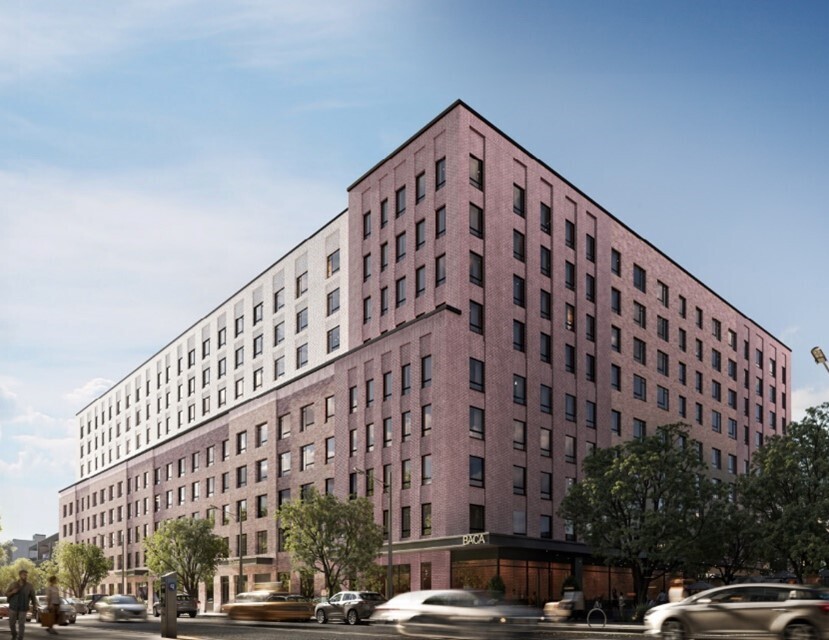By Elizabeth O’Brien
The Lower Manhattan Development Corporation returned to Chinatown last week to hold an extra meeting after protestors criticized the timing and the format of the neighborhood workshop held there three weeks ago.
Over July and August, the L.M.D.C. held a series of six brainstorming sessions for Downtowners, asking residents and workers for ideas on how the corporation should spend its remaining $1.3 billion. At the Chinatown meeting on July 31, participants interrupted L.M.D.C. speakers to ask why it had taken the corporation nearly two years after the Sept. 11 attacks to come to their neighborhood. Protestors outside the venue demanded that more people be allowed to join the invitation-only forum.
The L.M.D.C. scheduled a seventh workshop in response to these concerns, held last Thursday at P.S. 1 on Henry St. Community members needed an invitation to participate, but extensive efforts were made to include as many different people as possible, said Matthew Higgins, chief operating officer of the L.M.D.C.
“We’ve always said we’re willing to come back if necessary,” Higgins said before the event. “There was a feeling that there was more interest than could be accommodated in that night.”
Five police officers patrolled the entrance to the school and the meeting room, but the event passed without the kind of protests that characterized the first Chinatown workshop. Some participants applauded the L.M.D.C. for responding to their concerns and scheduling a second neighborhood meeting in a larger space than the first.
“I think it’s great,” said Kevin Chu, of the Garment Industry Development Corporation. Chu attended the previous Chinatown meeting, where he said that many people didn’t have time to voice their opinions to the entire group. “Hopefully, they’ll give everyone an opportunity today,” he added.
Community members did air their grievances, however. In a scheduled, 30-minute open mic session, people spoke of feeling neglected in the distribution of 9/11 aid and in the overall rebuilding process.
“We are not being taken care of down here,” said Sister Pietrina Raccuglia, head of Cabrini Immigrant Services on the Lower East Side.
Raccuglia and others spoke of what they called the arbitrary geographic boundaries that determined the amount of money residents could receive under the L.M.D.C. residential grant program. Some at the meeting said that they were denied residential grant money even though they lived in neighborhoods near the Twin Towers.
Mercedes Ruiz, of 175 Eldridge St., said that she is trying to appeal the L.M.D.C.’s rejection of her residential grant application. Since Ruiz, 82, lives north of Delancey St., her apartment falls outside the corporation’s three eligibility zones. Ruiz said that she lived only 260 ft. outside of Zone 3, according to the measurements of a construction worker. Residents of Zone 3 were eligible to receive a one-time payment of $1,000 from the L.M.D.C.
“I’m not going to get rich from $1,000,” Ruiz said. “It’s just the principle. We were left out.”
Ruiz said that many people in her building sought psychological counseling after the terror attack. Other residents spoke of asthma that had either developed or gotten worse since the trade center collapse.
The deadline for applying to the residential grant program expired in May. Joanna Rose, an L.M.D.C. spokesperson, said that she could not comment on whether the L.M.D.C. would retroactively revise the program’s eligibility criteria, but said that the corporation would consider all comments made at Thursday’s meeting.
After the open mic session, participants broke into five small groups of about 10 members each. While many criticized the L.M.D.C.’s local outreach efforts, most contributed eagerly in the small group sessions. The meeting room was not air-conditioned, and participants fanned themselves with L.M.D.C. brochures as they talked.
Community members were charged with suggesting ways to allocate the corporation’s $1.3 billion in remaining federal funds, as well as ways to prioritize potential projects. The $1.3 billion is part of the more than $2 billion the joint city-state agency received when it was created in response to the terror attacks of Sept. 11, 2001. Moderators told groups to focus their comments on areas outside the trade center site.
Job creation and affordable housing emerged as two popular concerns. Participants said that the community desperately needed more jobs, in part so that tenants would not have to struggle to pay the rent or fight eviction proceedings. Some suggested that the L.M.D.C. hire locals to work on its rebuilding projects.
Many also called for “real” affordable housing. Officials announced last month that $50 million would be set aside to build 315 apartments in Lower Manhattan for middle-income New Yorkers earning $50,000 to $85,000. Some participants said that this amount was way above the typical wages of Chinatown and Lower East Side workers, which in many cases fall under $20,000 a year.
In addition to specific needs, participants voiced concerns about L.M.D.C. procedure. Some expressed frustration that officials did not answer many questions during the meeting, saying instead that they were there to listen. The corporation did post a sheet near the door where participants could write down any remaining questions.
One item scrawled on a small group list read, “Action, not talk; Answers, not questions.”
“We would like accountability—it’s 23 months later,” said Bob Van Dyke, who runs a recording studio in Bowling Green and is one of the leaders of From the Ground Up, a group of Downtown small business owners.
While many concerns raised at Thursday’s meeting echoed those discussed at L.M.D.C. workshops in Tribeca, Battery Park City, and other neighborhoods, others seemed more particular to the area. Many residents of Chinatown and the Lower East Side spoke about the need for improved sanitation, for example. Another overwhelming priority was reopening Park Row, a major thoroughfare connecting parts of Broadway to Chinatown. Sections of Park Row have been closed since Sept. 11, 2001, because of the road’s proximity to police headquarters and a federal detention center. This has restricted access to the area and had a devastating effect on local businesses. A state judge has ordered New York City to conduct an environmental study of the street’s closure as a result of a lawsuit filed by residents, businesses and local politicians.
The L.M.D.C. will compile the feedback it has received at all seven neighborhood workshops in a report that will be released next month, Higgins said.
Paul Lee, a merchant on Mott St., said he had conflicting feelings about the process. On one hand, the L.M.D.C. came back to the neighborhood for another meeting and brought tasty sandwiches for dinner, he said. But those gestures meant little if the corporation didn’t really listen to participants’ suggestions and incorporate them into its planning, Lee added.
Said Lee, “Where do we go after tonight? I don’t know.”



























